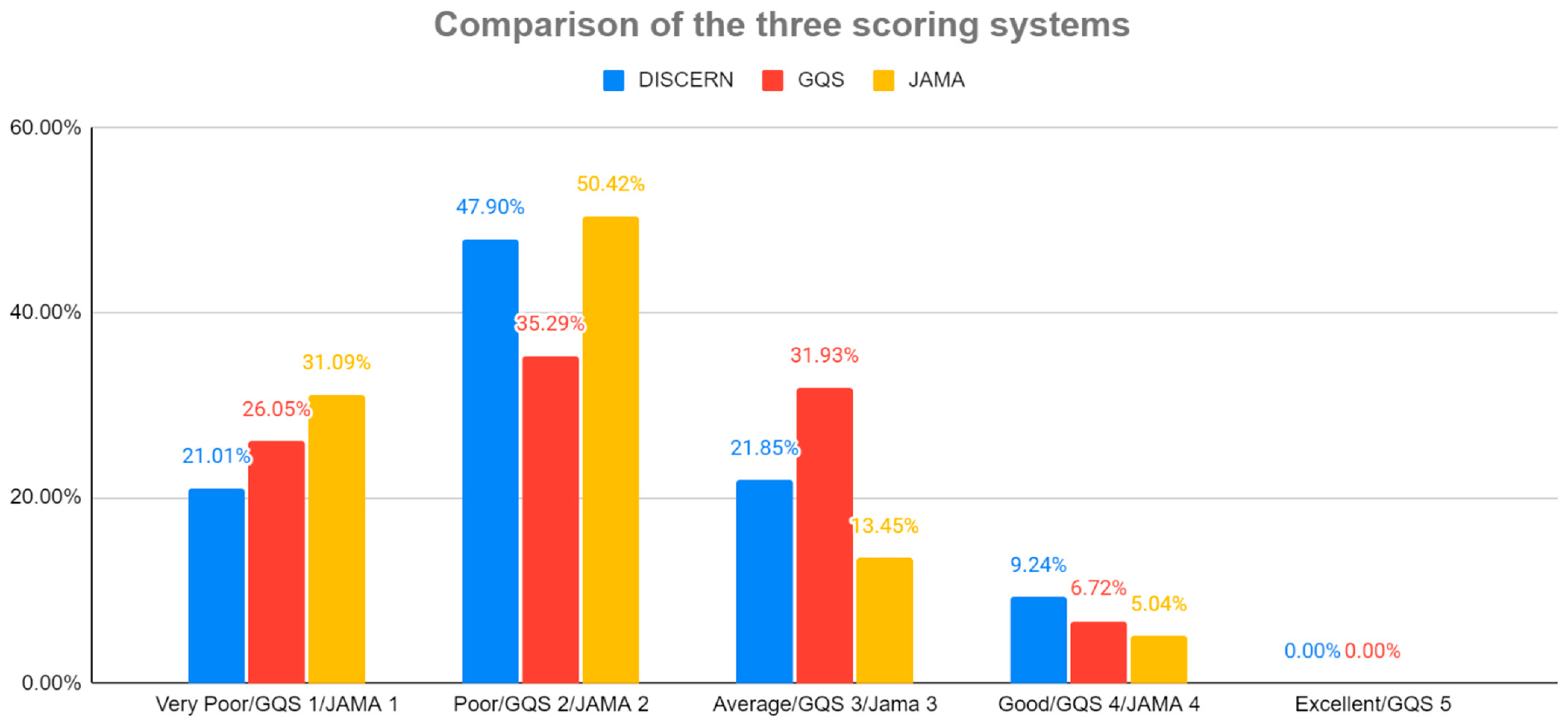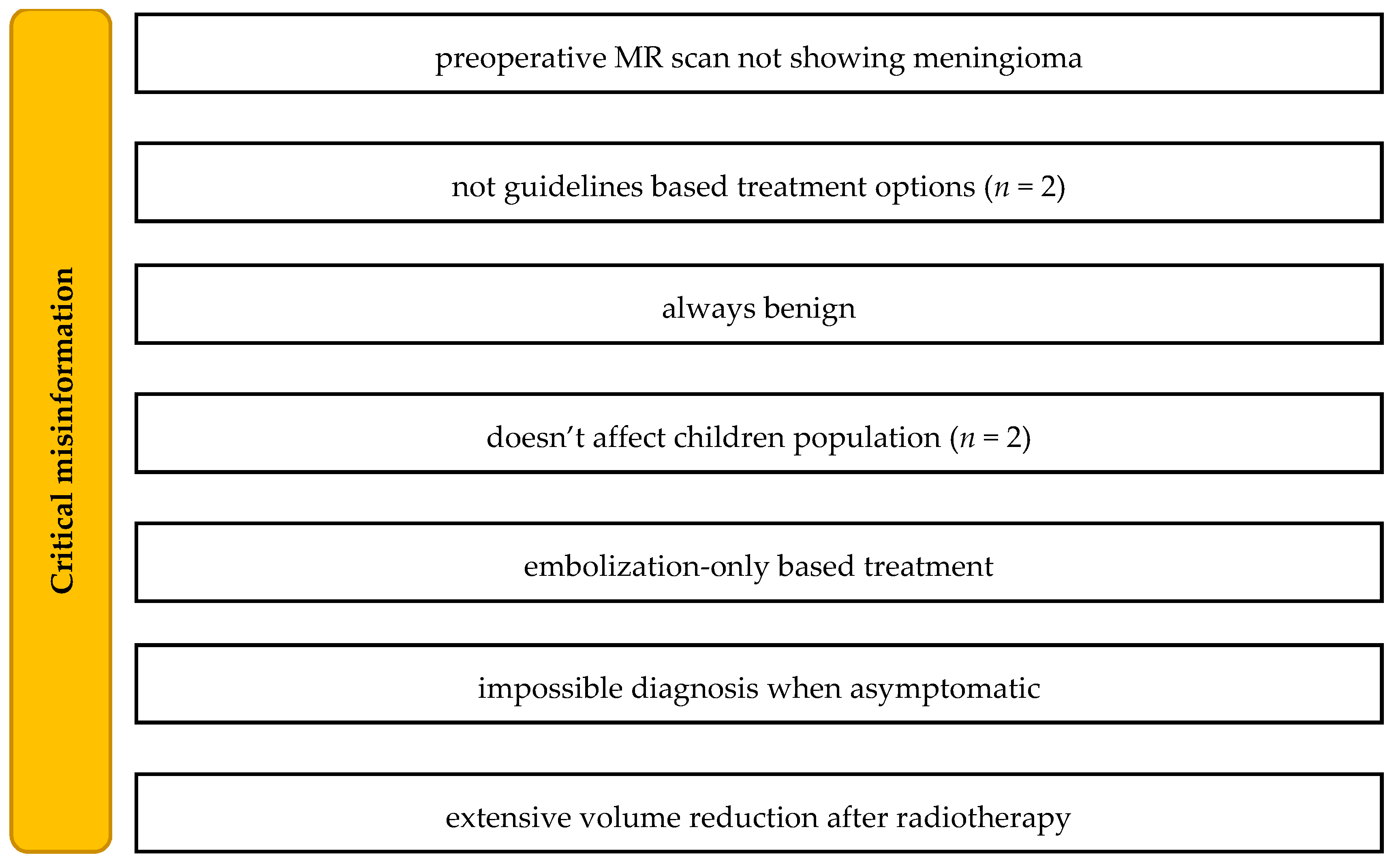YouTube as a Source of Patient Information for Meningiomas: A Content Quality and Audience Engagement Analysis
Abstract
:1. Introduction
2. Materials and Methods
2.1. Search Strategy and Data Collection
2.2. Inclusion and Exclusion Criteria
2.3. Variables Extracted
2.4. Scoring System
2.5. Audience Engagement
- (1)
- VPI = (likes × 100/(likes + dislikes)) × (views/day)/100;
- (2)
- Like Ratio = [likes/(likes + dislikes)] × 100.
2.6. Statistical Analysis
3. Results
3.1. Video Quality Analysis
3.2. Misleading Information
3.3. Audience Engagement
3.4. Top five DISCERN/VPI Videos
4. Discussion
4.1. The Current Study
4.2. Future Directions
4.3. Limitations
5. Conclusions
Supplementary Materials
Author Contributions
Funding
Institutional Review Board Statement
Informed Consent Statement
Data Availability Statement
Conflicts of Interest
Abbreviations
| DISCERN | Quality Criteria for Consumer Health Information |
| GQS | Global quality score |
| JAMA | Journal 14 of the American Medical Association instrument |
| VPI | Video power index |
| YT | YouTube |
References
- Saffi, H.; Do, T.P.; Hansen, J.M.; Dodick, D.W.; Ashina, M. The migraine landscape on YouTube: A review of YouTube as a source of information on migraine. Cephalalgia 2020, 40, 1363–1369. [Google Scholar] [CrossRef] [PubMed]
- ReFaey, K.; Tripathi, S.; Yoon, J.W.; Justice, J.; Kerezoudis, P.; Parney, I.F.; Bendok, B.R.; Chaichana, K.L.; Quiñones-Hinojosa, A. The reliability of YouTube videos in patients education for Glioblastoma Treatment. J. Clin. Neurosci. 2018, 55, 1–4. [Google Scholar] [CrossRef] [PubMed]
- Szmuda, T.; Alkhater, A.; Albrahim, M.; Alquraya, E.; Ali, S.; Al Dunquwah, R.; Słoniewski, P. YouTube as a source of patient information for stroke: A content-quality and an audience engagement analysis. J. Stroke Cerebrovasc. Dis. 2020, 29, 29–105065. [Google Scholar] [CrossRef] [PubMed]
- Szmuda, T.; Ali, S.; Kamieniecki, A.; Ręcławowicz, D.; Olofsson, H.K.L.; Słoniewski, P. YouTube as a source of patient information on brain aneurysms: A content-quality and audience engagement analysis. Neurol. I Neurochir. Pol. 2021, 55, 485–493. [Google Scholar] [CrossRef] [PubMed]
- Śledzińska, P.; Bebyn, M.G.; Furtak, J. Quality of YouTube Videos on Meningioma Treatment Using the DISCERN Instrument. World Neurosurg. 2021, 153, e179–e186. [Google Scholar] [CrossRef] [PubMed]
- Ogasawara, C.; Philbrick, B.; Adamson, D. Meningioma: A Review of Epidemiology, Pathology, Diagnosis, Treatment, and Future Directions. Biomedicines 2021, 9, 319. [Google Scholar] [CrossRef] [PubMed]
- Huntoon, K.; Toland, A.M.S.; Dahiya, S. Meningioma: A Review of Clinicopathological and Molecular Aspects. Front. Oncol. 2020, 10, 579599. [Google Scholar] [CrossRef] [PubMed]
- Magill, S.T.; Young, J.S.; Chae, R.; Aghi, M.K.; Theodosopoulos, P.V.; McDermott, M.W. Relationship between tumor location, size, and WHO grade in meningioma. Neurosurg. Focus 2018, 44, E4. [Google Scholar] [CrossRef] [PubMed] [Green Version]
- Szmuda, T.; Rosvall, P.; Hetzger, T.V.; Ali, S.; Słoniewski, P. YouTube as a Source of Patient Information for Hydrocephalus: A Content-Quality and Optimization Analysis. World Neurosurg. 2020, 138, e469–e477. [Google Scholar] [CrossRef] [PubMed]
- Krakowiak, M.; Szmuda, T.; Fercho, J.; Ali, S.; Maliszewska, Z.; Słoniewski, P. YouTube as a source of information for arteriovenous malformations: A content-quality and optimization analysis. Clin. Neurol. Neurosurg. 2021, 207, 106723. [Google Scholar] [CrossRef] [PubMed]
- The DISCERN Instrument. Available online: http://www.discern.org.uk/discern_instrument.php (accessed on 11 December 2021).
- Silberg, W.M.; Lundberg, G.D.; Musacchio, R.A. Assessing, Controlling, and Assuring the Quality of Medical Information on the Internet: Caveant lector et viewor—Let the reader and viewer beware. JAMA 1997, 277, 1244–1245. [Google Scholar] [CrossRef] [PubMed]
- Bernard, A.; Langille, M.; Hughes, S.; Rose, C.; Leddin, D.; Van Zanten, S.V. A Systematic Review of Patient Inflammatory Bowel Disease Information Resources on the World Wide Web. Am. J. Gastroenterol. 2007, 102, 2070–2077. [Google Scholar] [CrossRef] [PubMed]
- Erdem, M.N.; Karaca, S. Evaluating the Accuracy and Quality of the Information in Kyphosis Videos Shared on YouTube. Spine 2018, 43, E1334–E1339. [Google Scholar] [CrossRef] [PubMed]
- EN PQStat—Precision and Quality of Statistical Analysis. Available online: https://pqstat.pl/ (accessed on 28 February 2022).
- Koo, T.K.; Li, M.Y. A Guideline of Selecting and Reporting Intraclass Correlation Coefficients for Reliability Research. J. Chiropr. Med. 2016, 15, 155–163. [Google Scholar] [CrossRef] [PubMed] [Green Version]
- Hegarty, E.; Campbell, C.; Grammatopoulos, E.; DiBiase, A.T.; Sherriff, M.; Cobourne, M. YouTube™ as an information resource for orthognathic surgery. J. Orthod. 2017, 44, 90–96. [Google Scholar] [CrossRef] [PubMed]
- Samuel, N.; Alotaibi, N.; Lozano, A.M. YouTube as a Source of Information on Neurosurgery. World Neurosurg. 2017, 105, 394–398. [Google Scholar] [CrossRef] [PubMed]
- Ward, M.; Ward, B.; Abraham, M.; Nicheporuck, A.; Elkattawy, O.; Herschman, Y.; Mammis, A.; Liu, J.K.; Paskhover, B. The Educational Quality of Neurosurgical Resources on YouTube. World Neurosurg. 2019, 130, e660–e665. [Google Scholar] [CrossRef] [PubMed]
- Gokcen, H.B.; Gumussuyu, G. A Quality Analysis of Disc Herniation Videos on YouTube. World Neurosurg. 2019, 124, e799–e804. [Google Scholar] [CrossRef] [PubMed]
- Yaradılmış, Y.U.; Evren, A.T.; Okkaoğlu, M.C.; Öztürk, Ö.; Haberal, B.; Özdemir, M. Evaluation of quality and reliability of YouTube videos on spondylolisthesis. Interdiscip. Neurosurg. 2020, 22, 100827. [Google Scholar] [CrossRef]
- Kuru, T.; Erken, H.Y. Evaluation of the Quality and Reliability of YouTube Videos on Rotator Cuff Tears. Cureus 2020, 12, e6852. [Google Scholar] [CrossRef] [Green Version]
- Zincir, Ö.Ö.; Bozkurt, A.P.; Gaş, S. Potential Patient Education of YouTube Videos Related to Wisdom Tooth Surgical Removal. J. Craniofacial Surg. 2019, 30, e481–e484. [Google Scholar] [CrossRef] [PubMed]
- Betschart, P.; Pratsinis, M.; Müllhaupt, G.; Rechner, R.; Herrmann, T.R.; Gratzke, C.; Schmid, H.; Zumstein, V.; Abt, D. Information on surgical treatment of benign prostatic hyperplasia on YouTube is highly biased and misleading. Br. J. Urol. 2020, 125, 595–601. [Google Scholar] [CrossRef] [PubMed]
- Singh, A.G.; Singh, S.; Singh, P.P. YouTube for Information on Rheumatoid Arthritis—A Wakeup Call? J. Rheumatol. 2012, 39, 899–903. [Google Scholar] [CrossRef] [PubMed]
- Li, H.O.-Y.; Bailey, A.; Huynh, D.; Chan, J. YouTube as a source of information on COVID-19: A pandemic of misinformation? BMJ Glob. Health 2020, 5, e002604. [Google Scholar] [CrossRef] [PubMed]
- Loeb, S.; Sengupta, S.; Butaney, M.; Macaluso, J.N.; Czarniecki, S.W.; Robbins, R.; Braithwaite, R.S.; Gao, L.; Byrne, N.; Walter, D.; et al. Dissemination of Misinformative and Biased Information about Prostate Cancer on YouTube. Eur. Urol. 2019, 75, 564–567. [Google Scholar] [CrossRef] [PubMed]
- Langford, B.; Hooten, W.M.; D’Souza, S.; Moeschler, S.; D’Souza, R.S. YouTube as a Source of Medical Information about Spinal Cord Stimulation. Neuromodulation 2020, 24, 156–161. [Google Scholar] [CrossRef]
- Garg, N.; Venkatraman, A.; Pandey, A.; Kumar, N. YouTube as a source of information on dialysis: A content analysis. Nephrology 2015, 20, 315–320. [Google Scholar] [CrossRef]
- Kumar, N.; Pandey, A.; Venkatraman, A.; Garg, N. Are video sharing Web sites a useful source of information on hypertension? J. Am. Soc. Hypertens. 2014, 8, 481–490. [Google Scholar] [CrossRef]
- Krakowiak, M.; Rak, M.; Krakowiak, P.; Racisz, K.; Słoniewski, P.; Ilczak, T.; Krakowiak, A. YouTube as a source of information on carbon monoxide poisoning: A content-quality analysis. Int. J. Occup. Med. Environ. Health 2022, 35, 1–11. [Google Scholar] [CrossRef]
- Mustafa, A.G.; Taha, N.R.; Alshboul, O.A.; AlSalem, M.; Malki, M.I. Using YouTube to Learn Anatomy: Perspectives of Jordanian Medical Students. BioMed Res. Int. 2020, 2020, 6861416. [Google Scholar] [CrossRef] [Green Version]
- Louis, D.N.; Perry, A.; Wesseling, P.; Brat, D.J.; Cree, I.A.; Figarella-Branger, D.; Hawkins, C.; Ng, H.K.; Pfister, S.M.; Reifenberger, G.; et al. The 2021 WHO Classification of Tumors of the Central Nervous System: A summary. Neuro Oncol. 2021, 23, 1231–1251. [Google Scholar] [CrossRef] [PubMed]
- Goldbrunner, R.; Stavrinou, P.; Jenkinson, M.D.; Sahm, F.; Mawrin, C.; Weber, D.C.; Preusser, M.; Minniti, G.; Lund-Johansen, M.; Lefranc, F.; et al. EANO guideline on the diagnosis and management of meningiomas. Neuro Oncol. 2021, 23, 1821–1834. [Google Scholar] [CrossRef] [PubMed]
- Drozd, B.; Couvillon, E.; Suarez, A. Medical YouTube Videos and Methods of Evaluation: Literature Review. JMIR Med. Educ. 2018, 4, e3. [Google Scholar] [CrossRef] [PubMed] [Green Version]
- Azer, S.A. Are DISCERN and JAMA Suitable Instruments for Assessing YouTube Videos on Thyroid Cancer? Methodological Concerns. J. Cancer Educ. 2020, 35, 1267–1277. [Google Scholar] [CrossRef] [PubMed]






| Mean | Median | Sid | Min | Max | |
|---|---|---|---|---|---|
| Views | 24,210.47 | 5027.00 | 68,137.98 | 10.00 | 504,633.00 |
| Likes | 224.59 | 50.00 | 659.30 | 0.00 | 6000.00 |
| Dislikes | 8.29 | 1.00 | 24.91 | 0.00 | 228.00 |
| Comments | 26.74 | 4.00 | 96.68 | 0.00 | 881.00 |
| Subscribers | 53,936.77 | 24,000.00 | 88,249.26 | 118.00 | 426,000.00 |
| Time (s) | 1133.62 | 506.00 | 1416.63 | 40.00 | 6655.00 |
| Days since upload | 1688.71 | 1432.00 | 1098.97 | 280.00 | 5347.00 |
| VPI | 16.34 | 3.71 | 55.08 | 0.02 | 510.63 |
| Like ratio | 89.52 | 96.55 | 24.58 | 0.00 | 100.00 |
| DISCERN | Views | Likes | Dislikes | Comments | Subscribers | Time (s) | |
|---|---|---|---|---|---|---|---|
| Mean | 34.67 | 30,082.29 | 206.40 | 8.49 | 28.68 | 57,136.00 | 1016.91 |
| Median | 30.60 | 4159.00 | 36.00 | 1.00 | 7.00 | 26,300.00 | 316.00 |
| Standard deviation | 11.08 | 86,380.08 | 429.58 | 21.65 | 76.64 | 85,988.86 | 1334.72 |
| Minimum | 19.20 | 10.00 | 0.00 | 0.00 | 0.00 | 129.00 | 51.00 |
| Maximum | 62.00 | 504,633.00 | 2200.00 | 125.00 | 419.00 | 424,000.00 | 4702.00 |
Publisher’s Note: MDPI stays neutral with regard to jurisdictional claims in published maps and institutional affiliations. |
© 2022 by the authors. Licensee MDPI, Basel, Switzerland. This article is an open access article distributed under the terms and conditions of the Creative Commons Attribution (CC BY) license (https://creativecommons.org/licenses/by/4.0/).
Share and Cite
Krakowiak, M.; Fercho, J.; Piwowska, K.; Yuser, R.; Szmuda, T.; Słoniewski, P. YouTube as a Source of Patient Information for Meningiomas: A Content Quality and Audience Engagement Analysis. Healthcare 2022, 10, 506. https://doi.org/10.3390/healthcare10030506
Krakowiak M, Fercho J, Piwowska K, Yuser R, Szmuda T, Słoniewski P. YouTube as a Source of Patient Information for Meningiomas: A Content Quality and Audience Engagement Analysis. Healthcare. 2022; 10(3):506. https://doi.org/10.3390/healthcare10030506
Chicago/Turabian StyleKrakowiak, Michał, Justyna Fercho, Kaja Piwowska, Rami Yuser, Tomasz Szmuda, and Paweł Słoniewski. 2022. "YouTube as a Source of Patient Information for Meningiomas: A Content Quality and Audience Engagement Analysis" Healthcare 10, no. 3: 506. https://doi.org/10.3390/healthcare10030506
APA StyleKrakowiak, M., Fercho, J., Piwowska, K., Yuser, R., Szmuda, T., & Słoniewski, P. (2022). YouTube as a Source of Patient Information for Meningiomas: A Content Quality and Audience Engagement Analysis. Healthcare, 10(3), 506. https://doi.org/10.3390/healthcare10030506








